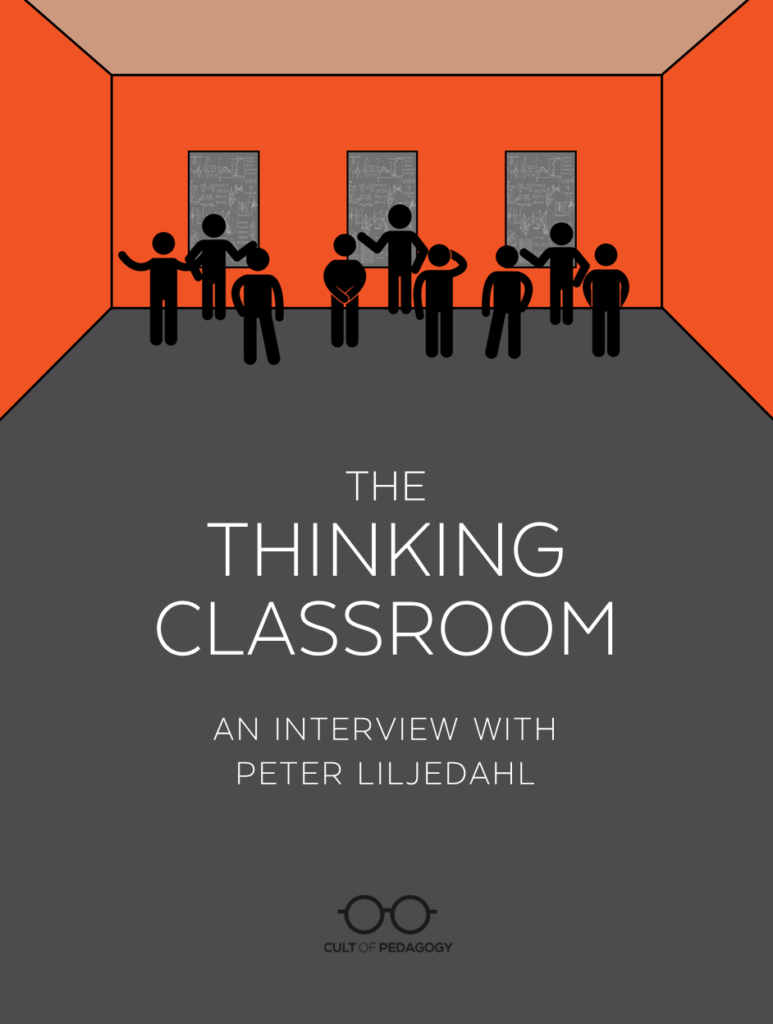
Listen to my interview with Peter Liljedahl (transcript):
Sponsored by Listenwise and Wipe book
This page contains Amazon Affiliate and Bookshop.org links. When you make a purchase through these links, Cult of Pedagogy gets a small percentage of the sale at no extra cost to you. What’s the difference between Amazon and Bookshop.org?
This post was supposed to be just for math teachers. I was going to share an instructional approach that, as dramatic as this sounds, has taken the math world by storm. The methodology is called Thinking Classrooms, and now that I have gotten a closer look at it, I can see that it can work in just about any content area. Built on 14 key practices, it’s a way of teaching that gets students up on their feet, collaborating and thinking through challenging problems on a daily basis.
When I first saw a video of this strategy in action, I was immediately captivated. take a look:
The more I learn about the Thinking Classrooms method, the better it gets. Thousands of math teachers are already using this approach, and it’s spreading to other subject areas as well.
Joining me to talk about this on the podcast is Peter Liljedahl, professor of mathematics education at Simon Fraser University in Vancouver, British Columbia, the creator of the Thinking Classrooms method, and the author of the book, Building Thinking Classrooms in Mathematics, Grades K-12: 14 Teaching Practices for Enhancing Learning (Amazon | Bookshop.org). In our interview, which you can listen to above, Liljedahl talked with me in depth about the Thinking Classroom. Some key points are summarized below.
How Thinking Classrooms Got Started
Liljedahl began to formulate his approach after spending hours observing in dozens of different math classrooms. What he saw was not surprising: classroom after classroom of students who were not engaged and were not actively learning.
“By and large students spend most of their class time not thinking, at least not in a way we know they need to think in order to be successful in mathematics.” Liljedahl explains. “If they’re not thinking, they’re not learning. And everywhere I go classrooms look more alike than they look different: Teaching and learning in math classrooms adheres to a set of normative structures that date back to the dawn of public education over 170 years ago. We’re going to have to break through some of these normative structures because they are actually creating environments that are not conducive to thinking.”
What followed was a 15-year process of figuring out how to break down these institutionally normative structures that were, as Liljedahl put it, “holding non-thinking in place.” Breaking those norms down means putting in place other practices that have now become foundational to the Thinking Classrooms approach.

The Practices
A Thinking Classroom is built on 14 practices, many of which were developed by looking at what was already happening in a typical classroom, doing the exact opposite, and seeing what happened. Some of the key practices are summarized below.
Thinking Tasks
Unlike in a more traditional classroom, where the lesson might start with direct instruction from the teacher, a typical day in a Thinking Classroom starts with the teacher assigning thinking tasks for students to work on in groups, and direct instruction is only given on an as -needed base.
“In a traditional classroom,” he explained, “we show the students how to do it, then we do one together, then they practice it on their own, the classic I do, we do, you dowhich promotes — whether you want it or not — a form of behavior called mimicking. So these students are just going to mimic their way through. In a Thinking Classroom, in order to get students to think rather than mimic, we have to remove the I do.”
When they are first introducing this approach, teachers are advised to make the thinking tasks non-curricular, fun challenges that will help develop a culture of thinking. Once students are used to the format, the tasks become curriculum-based, often the same kinds of problems you’d find in the resources you’d normally use, but Liljedahl points out that they are carefully sequenced, “very carefully constructed,” he says, “whereby the tasks are getting incrementally more challenging and are being given to students as their abilities are incrementally developing.”
Vertical, Non-permanent Surfaces
Perhaps the most distinctive feature of a Thinking Classroom is the use of vertical, non-permanent surfaces, where students do the tasks, standing up, in groups of three.
Why verticals? “When it goes vertical, everyone has the same orientation to the work,” Liljedahl explains. “When it’s vertical, they can see each other’s work, which promotes knowledge mobility and gives greater access to more ideas. When it’s vertical, I can see everything. I don’t have to wait for that quiz next Friday to see if the students understand it. I can see right now, and then I can intervene right now. I can’t do that if they’re horizontal.”
But there’s one more benefit of vertical surfaces that Liljedahl learned from interviewing students, one reason he felt eclipsed all the others. “It turns out that when students are sitting, they feel anonymous. And the further they sit from the teacher, the more anonymous they feel. And when students feel anonymous, they disengage. What stood up did was take away their anonymity. It made students not feel invisible, and then they didn’t disengage.”
The other important feature of these surfaces is that they are non-permanent. Unlike paper, which can’t be reused, an erasable surface like a whiteboard or chalkboard turns out to be more conducive to thinking tasks. Liljedahl and his colleagues found this out through experimentation.
“If we compare a group working on a whiteboard versus a group working on flip chart paper,” he says, “the group working on the whiteboards, they’ll start within 20 seconds. They’ll start making notations on the board. They’ll try anything and everything because they feel like they can just erase it if it’s wrong. The students who are tasked with working on flip chart paper, they will not make a single notation for upwards of three minutes, because ‘This is not erasable. What I put here has to be perfect.’ So there’s a lot of agonizing, and that hesitation leads to a lower form of thinking.”
Visibly Random Groups
Students collaborate on tasks in randomly assigned groups of three, and that randomization has become visible. Liljedahl explains why on the Building Thinking Classrooms website:
“Whether we grouped students strategically or we let students form their own groups, we found that 80% of students entered these groups with the mindset that, within this group, their job is not to think. However, when we frequently form visibly random groups, within six weeks, 100% of students entered their groups with the mindset that they were not only going to think, but that they were going to contribute. In addition, the use of frequent and visibly random groupings was shown to break down social barriers within the room, increase knowledge mobility, reduce stress, and increase enthusiasm for mathematics.”
Another important feature is that each group only gets one writing instrument; this forces members to collaborate, rather than work in parallel.
Consolidation Practices
Once students have worked through the assigned tasks at the boards, they transition into what Liljedahl calls consolidationactivities that reinforce each individual student’s learning.
“It turns out that there’s a difference between what we call collective knowing and doing and individual knowing and doing. Working collectively at the whiteboards and working individually are actually very different modalities; there needs to be some sort of transfer.”
The consolidation practices that facilitate that transfer are:
- guided gallery walkswhere the teacher points out key elements of student work on the vertical surfaces
- note makingwhere students construct their own meaningful notes: “They take their learning from the day and find a way to represent that in such a way that they can in part have a record, but more importantly go through that process of reificationwhere they are taking these ideas that started very informal and unstructured, became more formal and structured through the consolidation and now become even more formal and structured through their note making activity.”
- check your understanding questionsa form of self-assessment students do on their own to determine how well they have grasped the material
How to Get Started
The book (linked above) is a great place for math teachers to start, but if you’re not a math teacher, that shouldn’t stop you. “These practices are being enacted in every curriculum now,” Liljedahl says. “Language arts, social studies, science. There are slight variances to it, but fundamentally what changes is what constitutes a thinking task, which is Chapter 1 of the book, and what constitutes a sequence of thinking tasks, which is Chapter 9. Everything else stays more or less the same.”
Interested teachers should also join any one of the online communities of teachers who are already running Thinking Classrooms of their own. The largest is the Building Thinking Classrooms Facebook group, but Liljedahl says there are many others.
“Try it,” he says. “The book gives you plenty of resources and ways to enact it in a way that’s almost guaranteed to have some early success so that you can see for yourself what this looks like. I always say that my book has stories and data in it, but those are my stories and my data. The real data, the real stories that are going to impact your practice, that are going to sustain your practice, are the stories and the data that happened in your own classroom, right. give it a try. See what happens.”
Join our mailing list and get weekly tips, tools, and inspiration that will make your teaching more effective and fun. You’ll get access to our members-only library of free downloads, including 20 Ways to Cut Your Grading Time in Half, the e-booklet that has helped thousands of teachers save time on grading. Over 50,000 teachers have already joined—come on in.